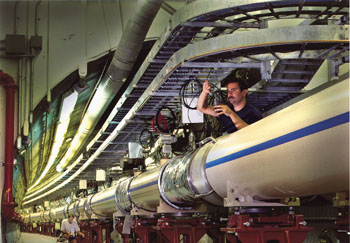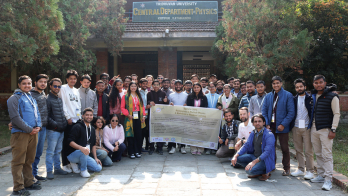A major report by a working group of the influential OECD Megascience forum provides a valuable snapshot of nuclear physics and makes far-reaching recommendations for its future direction.

The Organization for Economic Cooperation and Development (OECD), through its Megascience Forum, is making its wisdom felt in scientific circles, acting as a valuable catalyst for future developments and as a focus for international collaboration in sectors where this is not yet centrally organized.
Founded in 1960, the OECD is a grouping of nations with advanced economies, its aim being to improve economic and social conditions in its own sector, stimulating relations with developing countries and generally boosting world trade.
Megascience Forum
Its initial concerns were economic and financial, but the roles of science and technology have been identified as being of major importance, hence the creation of the Megascience Forum. Its latest exercise is a report by a special working group that was set up in 1996 under Bernard Frois of Saclay to look into nuclear physics and its worldwide implications.
Nuclear physics is pursued in all OECD member countries (and many others) with a global annual investment of about $1 billion. Nuclear physics has a major impact on technology and society: energy production, biological research, medical imaging, cancer treatment, semiconductor manufacturing, materials science, food processing, environmental monitoring and protection, preservation of art works, archaeology and anthropology.
As scientists probe ever deeper into the structure of nuclear matter, they require larger and increasingly complex facilities and equipment. In most cases these are unique, dedicated facilities, distinct from those of particle physics. The long lead times and considerable resources needed call for strategic decision-making and long-range planning, with a careful consideration of the scientific, technological, economic and social benefits of nuclear research. These requirements are especially critical now, when research budgets are under pressure.
The goals of the Megascience Working Group were to provide an international forum for the exchange of information on priorities, programmes and plans, and to explore opportunities for international collaboration during the next 10 to 20 years.
Particular attention was given to the role of large facilities and programmes that would benefit from international co-operation:
- to examine the policies and practices that govern access to large facilities,
and to assess the impact of current and future trends on the users and providers of international facilities; - to explore specific opportunities for collaboration in research and development related to nuclear physics facilities,
detectors and associated technologies.

Scientific objectives and applications
The fundamental challenges of nuclear physics are not the same as those of particle physics.
What are the constituents of matter, how do they interact and how do they form nuclei?
For nuclear physics, the aim is to understand the properties of nuclear particles from those of quarks and gluons, to solve the nuclear many-body problem and to predict the properties of large nuclei from the known interaction of protons and neutrons. These formidable theoretical problems may become tractable using high -power computers and results from new generations of electron and hadron beam facilities.
What are the limits of nuclear stability?
The early evolution of the universe was determined by the aggregation of quarks and gluons to form hadrons and nuclei, and the synthesis of heavier elements through nuclear reactions. The stability of nuclei arises from a delicate balance between the nuclear, electromagnetic and weak forces in the nuclear medium.
Some very neutron-rich nuclei have recently been found to have extended distributions of dilute, nearly pure neutron matter that are of much theoretical interest and thus a subject of intense investigation. The direct investigation of nuclear structure far from stability will be made possible through the production of intense beams of rare and short-lived isotopes (radioactive beams).
What happens to nuclear matter at extreme pressures and temperatures?
Nuclei can be compared to liquid drops of nuclear matter. In the collision between two nuclei at high energy, the pressure and temperature of nuclear matter are increased. Is there a transition in the nature of nuclear matter? Is there formation of a plasma of elementary constituents in ultrahigh-energy collisions of heavy nuclei? The search for these phase transitions via heavy-ion collision experiments will be a subject of intense experimental and theoretical work during the next decade.
The liquidgas phase transition is studied at existing energies. The “deconfinement” transition to a quarkgluon plasma will be investigated in new regimes at Brookhaven’s RHIC and CERN’s LHC colliders. The early universe presumably underwent this phase transition within the first few millionths of a second following the Big Bang.
Such phenomena might have a bearing on important aspects of cosmology, such as nucleosynthesis, dark matter and the large-scale structure of the universe. In astrophysics, the dynamics of supernova explosions and the stability of neutron stars depend on the compressibility and thus the equation of state of nuclear matter.
What is the origin of the chemical elements in the cosmos?
Many elements are formed in stellar explosions via very neutron-rich or, under different circumstances, very proton-rich nuclei. The properties of both routes are largely unknown. While element formation inside stars can be sketched by extrapolating model calculations, there is a critical need for experimental data to provide benchmark tests for these predictions or input to numerical simulations.
Nuclear methods are widely used in materials research and manufacturing. Some examples are non-destructive testing via computerized tomography or neutron radiography, the production of densely packed microchips by ion implantation and the sterilization of heat-sensitive materials by ionizing radiation.
Materials analysis using nuclear reactions and Rutherford scattering is a major research tool for surface analysis, catalysis, semiconductor manufacturing, archaeology, etc.
Particle beams from research accelerators are used to analyse the damage to microelectronic circuits that is caused by cosmic radiation or natural radioactivity an issue of increasing importance for the further miniaturization of electronics.
Ultrasensitive accelerator mass spectrometry plays an increasing role in environmental research the study of climatic change, global air and water circulation patterns, stratospheric ozone depletion, and the monitoring of air and water quality. Nuclear technology is indispensable in the monitoring of existing radioactive waste repositories.
For energy production, nuclear fission reactors currently provide about 17% of the world’s electricity. Nuclear techniques have an impact on other forms of energy production, including the exploration and utilization of oil reserves. Neutron techniques are routinely used to monitor the chemical composition of coal, coal preparation plants and the determination of the sulphur, water, ash and energy content of coal. For the long term, thermonuclear fusion still holds the promise of a virtually inexhaustible supply of clean energy and is an area of active research and development.
Nuclear techniques are important in medicine and biology. Radioactive isotopes produced by accelerators and nuclear reactors are widely used for treatment and diagnosis, and also in biomedical research.
In the wide-ranging applications sector, the working group focused on three potentially promising topics: the accelerator-driven transmutation of nuclear wastes, medical imaging and cancer therapy.





